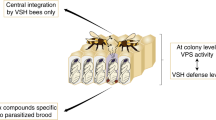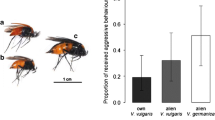Abstract
Social insect colonies provide a stable and safe environment for their members. Despite colonies being heavily guarded, parasites have evolved numerous strategies to invade and inhabit these hostile places. Two such strategies are (true) chemical mimicry via biosynthesis of host odor, and chemical camouflage, in which compounds are acquired from the host. The ectoparasitic mite Varroa destructor feeds on hemolymph of its honey bee host, Apis mellifera. The mite’s odor closely resembles that of its host, which allows V. destructor to remain undetected as it lives on the adult host during its phoretic phase and while reproducing on the honeybee brood. During the mite life cycle, it switches between host adults and brood, which requires it to adjust its profile to mimic the very different odors of honey bee brood and adults. In a series of transfer experiments, using bee adults and pupae, we tested whether V. destructor changes its profile by synthesizing compounds or by using chemical camouflage. We show that V. destructor required direct access to host cuticle to mimic its odor, and that it was unable to synthesize host-specific compounds itself. The mite was able to mimic host odor, even when dead, indicating a passive physico-chemical mechanism of the parasite cuticle. The chemical profile of V. destructor was adjusted within 3 to 9 h after switching hosts, demonstrating that passive camouflage is a highly efficient, fast and flexible way for the mite to adapt to a new host profile when moving between different host life stages or colonies.



Similar content being viewed by others
References
Akino T, Yamaoka R (1998) Chemical mimicry in the root aphid parasitoid Paralipsis eikoae Yasumatsu (Hymenoptera: Aphidiidae) of the aphid-attending ant Lasius sakagamii Yamauchi & Hayashida (Hymenoptera: Formicidae). Chemoecology 8:153–161
Akino T, Knapp JJ, Thomas JA, Elmes GW (1999) Chemical mimicry and host specificity in the butterfly Maculinea rebeli, a social parasite of Myrmica ant colonies. Proc R Soc B 266:1419–1426
Arnold G, Quenet B, Masson C (2000) Influence of social environment on genetically based subfamily signature in the honeybee. J Chem Ecol 26:2321–2333
Aumeier P, Rosenkranz P, Francke W (2002) Cuticular volatiles, attractivity of worker larvae and invasion of brood cells by Varroa mites. A comparison of Africanized and European honey bees. Chemoecology 12:65–75
Bagnères A-G, Lorenzi MC (2010) Chemical deception/mimicry using cuticular hydrocarbons. In: Blomquist GJ, Bagnères A-G (eds) Insect hydrocarbons: biology, biochemistry, and chemical ecology. University Press, Cambridge, pp 282–324
Blomquist GJ, Bagnères A-G (2010) Insect hydrocarbons: biology, biochemistry, and chemical ecology. University Press, Cambridge
Buchwald R, Breed MD (2005) Nestmate recognition cues in a stingless bee, Trigona fulviventris. Anim Behav 70:1331–1337
Buckner JS, Pitts-singer TL, Guedot C, Hagen MM, Fatland CL, Kemp WP (2009) Cuticular lipids of female solitary bees, Osmia lignaria Say and Megachile rotundata (F.) (Hymenoptera: Megachilidae). Comp Biochem Physiol B 153:200–205
Cini A, Bruschini C, Signorotti L, Pontieri L, Turillazzi S, Cervo R (2011) The chemical basis of host nest detection and chemical integration in a cuckoo paper wasp. J Exp Biol 214:3698–3703
de Renobales M, Nelson DR, MacKay ME, Zamboni AC, Blomquist GJ (1988) Dynamics of hydrocarbon biosynthesis and transport to the cuticle during pupal and early adult development in the cabbage looper Trichoplusia ni (Lepidoptera: Noctuidae). Insect Biochem 18:607–613
Dettner K, Liepert C (1994) Chemical mimicry and camouflage. Annu Rev Entomol 39:129–154
Everaerts C, Farine JP, Brossut R (1997) Changes of species specific cuticular hydrocarbon profiles in the cockroaches Nauphoeta cinerea and Leucophaea maderae reared in heterospecific groups. Entomol Exp Appl 85:145–150
Falcón T, Ferreira-Caliman MJ, Nunes FMF, Tanaka ED, do Nascimento FS, Bitondi MMG (2014) Exoskeleton formation in Apis mellifera: cuticular hydrocarbons profiles and expression of desaturase and elongase genes during pupal and adult development. insect. J Biochem Mol Biol 50:68–81
Franks N, Blum MS, Smith R, Allies AB (1990) Behavior and chemical disguise of cuckoo ant Leptothorax kutteri in relation to its host Leptothorax acervorum. J Chem Ecol 16:1431–1444
Gibbs A (1995) Physical properties of insect cuticular hydrocarbons: model mixtures and lipid interactions. Comp Biochem Physiol B 112:667–672
Hojo MK, Wada-Katsumata A, Akino T, Yamaguchi S, Ozaki M, Yamaoka R (2009) Chemical disguise as particular caste of host ants in the ant inquiline parasite Niphanda fusca (Lepidoptera: Lycaenidae). Proc R Soc B 276:551–558
Hölldobler B, Wilson EO (1990) The ants. Harvard University Press, Cambridge
Howard RW, McDaniel CA, Blomquist GJ (1982) Chemical mimicry as an integrating mechanism for three termitophiles associated with Reticulitermes virginicus (Banks). Psyche 89:157–167
Howard RW, Stanley-Samuelson DW, Akre RD (1990) Biosynthesis and chemical mimicry of cuticular hydrocarbons from the obligate predator, Microdon albicomatus Novak (Diptera: Syrphidae) and its ant prey, Myrmica incompleta Provancher (Hymenoptera: Formicidae). J Kansas Entomol Soc 63:437–443
Ichinose K, Lenoir A (2009) Ontogeny of hyrdrocarbon profiles in the ant Aphanogaster senilis and effects of social isolation. C R Biologies 332:697–703
Jeral JM, Breed MD, Hibbard BE (1997) Thief ants have reduced quantities of cuticular compounds in a ponerine ant, Ectatomma ruidum. Physiol Entomol 22:207–211
Kaib M, Jmhasly P, Wilfert L, Durka W, Franke S, Francke W, Leuthold RH, Brandl R (2004) Cuticular hydrocarbons and aggression in the termite Macrotermes subhyalinus. J Chem Ecol 30:365–385
Kather R, Drijfhout FP, Martin SJ (2011) Task group differences in cuticular lipids in the honey bee Apis mellifera. J Chem Ecol 37:205–212
Kather R, Drijfhout F P, Shemilt S, Martin S J (2015) Evidence for colony-specific differences in chemical mimicry in the parasitic mite Varroa destructor. Chemecology (accepted)
Kraus B, Koeniger N, Fuchs S (1986) Unterscheidung zwischen Bienen verschiedenen Alters durch Varroa jacobsoni Oud. und Bevorzugung von Ammenbienenvolk. Apidologie 17:257–266
Kroiss J, Schmitt T, Strohm E (2009) Low level of cuticular hydrocarbons in a parasitoid of a solitary digger wasp and its potential for concealment. J Entomol Sci 12:9–16
Lenoir A, Malosse C, Yamaoka R (1997) Chemical mimicry between parasitic ants of the genus Formicoxenus and their host Myrmica (Hymenoptera, Formicidae). Biochem Syst Ecol 25:379–389
Lenoir A, Fresneau D, Errard C, Hefetz A (1999) The individuality and the colonial identity in ants: the emergence of the social representation concept. In: Detrain C, Deneubourg JL, Pasteels J (eds) Information processing in social insects. Birkhäuser Verlag, Basel, pp 219–237
Lenoir A, D’Ettorre P, Errard C, Hefetz A (2001) Chemical ecology and social parasitism in ants. Annu Rev Entomol 46:573–599
Lorenzi MC, Bagnères AG (2002) Concealing identity and mimicking hosts: a dual chemical strategy for a single social parasite? (Polistes atrimandibularis, Hymenoptera: Vespidae). Parasitology 125:507–512
Martin SJ, Drijfhout FP (2009) A review of ant cuticular hydrocarbons. J Chem Ecol 35:1151–1161
Martin C, Salvy M, Provost ÉM, Bagnéres AG, Roux M, Crauser D, Clement JL, Le Conte Y (2001) Variations in chemical mimicry by the ectoparasitic mite Varroa jacobsoni according to the developmental stage of the host honey-bee Apis mellifera. Insect Biochem Mol Biol 31:365–379
Martin SJ, Vitikainen E, Shemilt S, Drijfhout FP, Sundstrom L (2013) Sources of variation in cuticular hydrocarbons in the ant Formica exsecta? J Chem Ecol 39:1415–1423
Nation JL, Sanfor MT, Milne K (1992) Cuticular hydrocarbons from Varroa jacobsoni. Exp Appl Acarol 16:331–344
Rosenkranz P, Aumeier P, Ziegelmann B (2010) Biology and control of Varroa destructor. J Invert Pathol 103:S96–S119
Turillazzi S, Sledge MF, Dapporto L, Landi M, Fanelli D, Fondelli L, Zanetti P, Dani F (2004) Epicuticular lipids and fertility in primitively social wasps (Hymenoptera Stenogastrinae). Physiol Entomol 29:464–471
Uboni A, Bagnères A-G, Christidès J-P, Lorenziet MG (2012) Cleptoparasites, social parasites and a common host: chemical insignificance for visiting host nests, chemical mimicry for living in. J Insect Physiol 58:1259–1264
Vander Meer RK, Wojcik DP (1982) Chemical Mimicry in the Myrmecophilous beetle Myrmecaphodius excavaticollis. Science 218:806–808
Vauchot B, Provost E, Bagnères A-G, Riviere G, Roux M, Clément J-L (1998) Differential adsorption of allospecific hydrocarbons by the cuticles of two termite species, Reticulitermes santonensis and R. lucifugus grassei, Living in a Mixed Colony. J Insect Physiol 44:59–66
Vienne C, Soroker V, Hefetz A (1995) Congruency of hydrocarbon patterns in heterospecific groups of ants: transfer and/or biosynthesis ? Insectes Sociaux 42:267--277
von Beeren C, Schulz S, Hashim R, Witte V (2011) Acquisition of chemical recognition cues facilitates integration into ant societies. BMC Ecol 11:30
von Beeren C, Hashim R, Witte V (2012) The social integration of a myrmecophilous spider does not depend exclusively on chemical mimicry. J Chem Ecol 38:262–271
Wilson EO (1971) The insect societies. Belknap, Harvard
Acknowledgments
We thank the Kings Lynn, Sheffield and Barnsley Beekeepers for providing mites and Roger Butlin of Sheffield University for comments along with the two excellent reviews. This research was funded by funding from BBSRC (BB/G017077/1), and the East Anglian Beekeepers (EARS).
Author information
Authors and Affiliations
Corresponding author
Rights and permissions
About this article
Cite this article
Kather, R., Drijfhout, F.P., Shemilt, S. et al. Evidence for Passive Chemical Camouflage in the Parasitic Mite Varroa destructor . J Chem Ecol 41, 178–186 (2015). https://doi.org/10.1007/s10886-015-0548-z
Received:
Revised:
Accepted:
Published:
Issue Date:
DOI: https://doi.org/10.1007/s10886-015-0548-z




